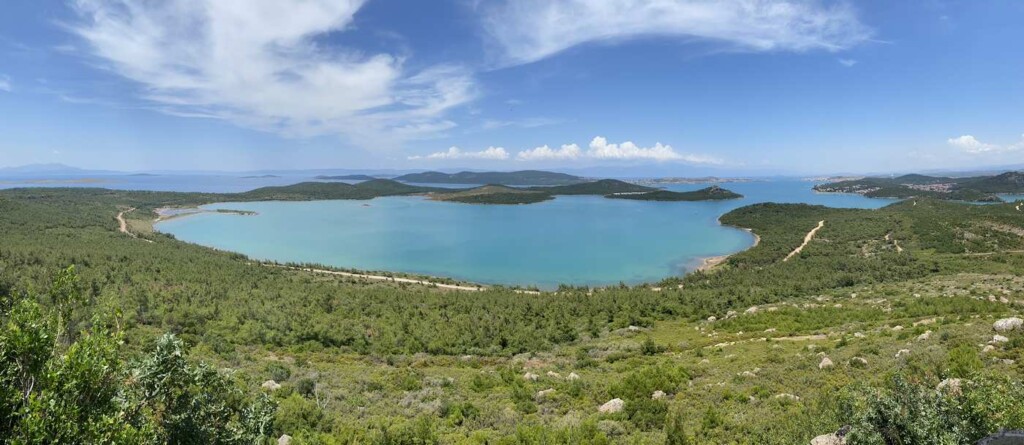Female Archaeologists Uncover Lost Land Bridge That May Rewrite European History

Stretches of land, now hidden beneath the sea, may have given early humans a way to move between what is today Turkey and Europe, according to groundbreaking new research in this little-studied region.
The recently published study reveals the first evidence of Paleolithic activity in Ayvalık, and may reshape how scientists understand our species’ journey into Europe.
The prehistoric peopling of Europe has long been documented as occurring in waves from the western edge of Eurasia. For decades, experts believed that Homo sapiens reached Europe mainly by traveling through the Balkans and the Levant, moving from Africa into the Middle East.
However, the discovery of 138 stone tools spread across 10 sites within a 200 km² area suggests a different possibility.
According to a study published in the peer-reviewed Journal of Island and Coastal Archaeology, long before Ayvalık became known for its olive groves and seaside scenery, this part of the northeastern Aegean coast (now in Turkey) may have served as another key passageway for ancient humans exploring a shifting prehistoric world.
“It was a truly unforgettable moment for us, holding the first tools in our hands was both emotional and inspiring,” explains Dr. Göknur Karahan, from the Department of Archaeology-Prehistory, at Hacettepe University, in Turkey, who was part of a fully female team of expert archaeologists from the country.
“And each find from there on was a moment of excitement for the whole team. Our archaeological discovery has unveiled that this now-idyllic region once potentially offered a vital land bridge for human movement during the Pleistocene era—when sea levels dropped and the now-submerged landscape was briefly exposed.”

“We are very excited and delighted with this discovery. These findings mark Ayvalık as a potential new frontier in the story of human evolution, placing it firmly on the map of human prehistory—opening up a new possibility for how early humans may have entered Europe,” Karahan added. “It feels like we are adding an entirely new page to the story of human dispersal.”
During the Ice Age, sea levels dropped more than 300 feet, revealing vast coastal plains that are now underwater. At that time, the modern islands and peninsulas of Ayvalık would have formed a single stretch of land, creating a natural bridge that linked Anatolia to Europe.
The artifacts found in the new study were discovered along the present-day coastline, providing evidence that people once lived and traveled across these now-submerged landscapes.
Until now, environmental conditions and deep sediment layers had made it difficult to detect or preserve traces of early human activity in the region.
“In all these periods, the present-day islands and peninsulas of Ayvalık would have formed interior zones within an expansive terrestrial environment,” explains co-author Professor Kadriye Özçelik, from Ankara University.
The region’s shifting geology and active coastlines in the North Aegean made preservation difficult and the number of items uncovered “limited,” however this research team managed to uncover Levallois-style stone cutting technologies from various Paleolithic periods, as well as handaxes and cleavers.
Among the most significant finds include Levallois-style flake tools, sophisticated implements often associated with Neanderthals and early Homo sapiens.
TURKISH STORIES: Breathtaking Lake Salda Is the Only Place on Earth That’s Like a Mars Crater, Scientists Say
“These large cutting tools are among the most iconic artifacts of the Paleolithic and are instantly recognizable even today, so are a very important find,” explains Dr. Karahan.
“The presence of these objects in Ayvalık is particularly significant, as they provide direct evidence that the region was part of wider technological traditions shared across Africa, Asia, and Europe.”
“Holding these objects—after walking across landscapes where no one had ever documented Paleolithic remains before—was unforgettable.”
MORE PALEOARCHAEOLOGY: Scientists Use Stones to Build Canoe Like Their Ancestors and Sailed it 140 Miles Across Dangerous Waters
The authors collectively recommended further research in the area that would integrate absolute dating, stratigraphic excavation, and paleoenvironmental reconstruction to better clarify the the time periods when the tools were used.
“Multidisciplinary approaches will help illuminate the region’s role not as a peripheral landscape, but as an active corridor of Paleolithic interaction and innovation.”






Please be good and do not spam. Thank you.